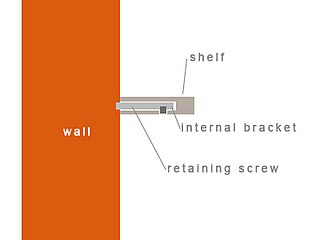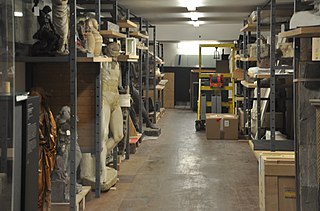
A closet is an enclosed space, with a door, used for storage, particularly that of clothes. Fitted closets are built into the walls of the house so that they take up no apparent space in the room. Closets are often built under stairs, thereby using awkward space that would otherwise go unused.

A settle is a wooden bench, usually with arms and a high back, long enough to accommodate three or four sitters.

A pantry is a room or cupboard where beverages, food, (sometimes) dishes, household cleaning products, linens or provisions are stored within a home or office. Food and beverage pantries serve in an ancillary capacity to the kitchen.

A sideboard, also called a buffet, is an item of furniture traditionally used in the dining room for serving food, for displaying serving dishes, and for storage. It usually consists of a set of cabinets, or cupboards, and one or more drawers, all topped by a wooden surface for conveniently holding food, serving dishes, or lighting devices. The words sideboard and buffet are somewhat interchangeable, but if the item has short legs, or a base that sits directly on the floor with no legs, it is more likely to be called a sideboard; if it has longer legs, it is more likely to be called a buffet.

A bookcase, or bookshelf, is a piece of furniture with horizontal shelves, often in a cabinet, used to store books or other printed materials. Bookcases are used in private homes, public and university libraries, offices, schools, and bookstores. Bookcases range from small, low models the height of a table to high models reaching up to ceiling height. Shelves may be fixed or adjustable to different positions in the case. In rooms entirely devoted to the storage of books, such as libraries, they may be permanently fixed to the walls and/or floor.

A chest of drawers, also called a dresser or a bureau, is a type of cabinet that has multiple parallel, horizontal drawers generally stacked one above another.

A cupboard is a piece of furniture for enclosing dishware or grocery items that are stored in a home. The term gradually evolved from its original meaning: an open-shelved side table for displaying dishware, more specifically plates, cups and saucers.

A credenza is a dining room sideboard or display cabinet, usually made of burnished and polished wood and decorated with marquetry. The top would often be made of marble, or another decorative liquid- and heat-resistant stone.

Mizuya is the term for the preparation area in a Japanese tea house or attached to any venue used for the Japanese tea ceremony. For instance, the area used for preparation during outdoor tea ceremonies is also called the mizuya. The term mizuya can also refer to purificatory fonts at shrines and temples, as well as to storage cupboards for use in kitchens. This article, however, focuses on the tea ceremony mizuya.

A hutch is an American English word for a particular type of furniture with a set of shelves or cabinets placed on top of a lower unit with a counter and either drawers or cabinets. Modern hutches are typically made of timber. The term originates from a hutch table.
A wardrobe, also called armoire or almirah, is a standing closet used for storing clothes. The earliest wardrobe was a chest, and it was not until some degree of luxury was attained in regal palaces and the castles of powerful nobles that separate accommodation was provided for the apparel of the great. The name of wardrobe was then given to a room in which the wall-space was filled with closets and lockers, the drawer being a comparatively modern invention. From these cupboards and lockers the modern wardrobe, with its hanging spaces, sliding shelves and drawers, evolved slowly.

A baker's rack is a type of furniture with shelves, typically made of wrought iron or some other metal. "Since the 17th century, baker's racks have been part of many homes around the world. This versatile storage furniture has gained its name because it has been originally used by bakers." The shelves are made of a conductive material, often steel or iron, which served to help cool a baker's goods such as hot pies, breads, and pastries. The conductivity and thermal mass of metal not only allows for heat to be quickly transferred from the pan to the shelf, but held for a long time. This allowed the cooling process to be equally distributed so baked goods maintained their integrity.

A pot rack is a functional piece of kitchen furniture that is used to hang or store cooking pots and pans. Steel, wood, wrought iron, and a few other metals are the most common types of materials used for pot racks. Pot racks also usually have some type of finish or stain to help them match pots and decor. In addition, pot racks can range in size from less than a foot to over fifteen feet long. These larger pot racks are capable of supporting dozens of pots and pans.

A floating shelf is a form of shelf with its wall fixings hidden within the shelf board, with no visible supporting brackets. It is believed that late 1950's contemporary designer Magnus McCormick invented the floating shelf, however it is unclear if he was the first to use them. Needless to say, floating shelves have become a timeless furniture icon in the 21st century.

A Welsh dresser or a china hutch, sometimes known as a kitchen dresser or pewter cupboard, is a piece of wooden furniture consisting of drawers and cupboards in the lower part, with shelves and perhaps a sideboard on top. Traditionally, it is a utilitarian piece of furniture used to store and display crockery, silverware and pewter-ware, but is also used to display general ornaments.

A shelf is a flat, horizontal plane used for items that are displayed or stored in a home, business, store, or elsewhere. It is raised off the floor and often anchored to a wall, supported on its shorter length sides by brackets, or otherwise anchored to cabinetry by brackets, dowels, screws, or nails. It can also be held up by columns or pillars. A shelf is also known as a counter, ledge, mantel, or rack. Tables designed to be placed against a wall, possibly mounted, are known as console tables, and are similar to individual shelves.
Adjustable shelving allows more flexible use of shelves to hold items of value for storage, display or sale. Like fixed shelves, the horizontal planes are normally made of strong materials such as wood or steel, but their exact vertical positioning can be varied - usually through the use of uprights into which supporting brackets or the shelves themselves can be fixed at different heights.

A cabinet is a case or cupboard with shelves and/or drawers for storing or displaying items. Some cabinets are stand alone while others are built in to a wall or are attached to it like a medicine cabinet. Cabinets are typically made of wood, coated steel, or synthetic materials. Commercial grade cabinets usually have a melamine-particleboard substrate and are covered in a high pressure decorative laminate, commonly referred to as Wilsonart or Formica.

The cultural property storage typically falls to the responsibility of cultural heritage institutions, or individuals. The proper storage of these objects can help to ensure a longer lifespan for the object with minimal damage or degradation. With so many different types of artifacts, materials, and combinations of materials, keepers of these artifacts often have considerable knowledge of the best practices in storing these objects to preserve their original state.


















